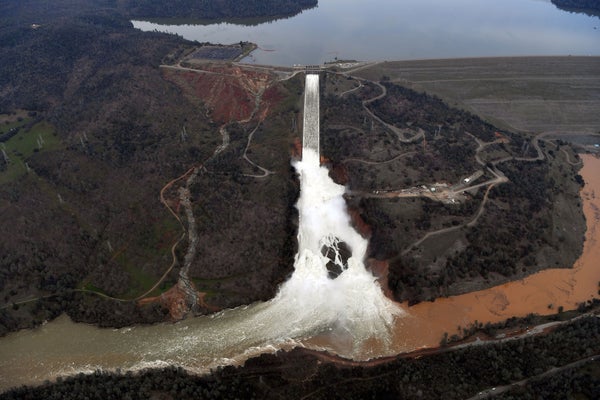By now we have all seen the spectacular images of volumes of water crashing down the Oroville Dam spillway in California and blasting upward into the air as they hit an enormous crater in the spillway floor, flooding down the adjacent hillside, threatening people in towns below. Those images reveal a big mistake: failure to update infrastructure to defend against climate change.
The menacing floodwaters last week forced the emergency evacuation of 188,000 residents. Yet the impending disaster came as no surprise to officials in Butte and Plumas counties. The rural counties, which surround Lake Oroville, had challenged the state’s environmental review of dam operations in a 2008 lawsuit, arguing the state "recklessly failed" to properly account for climate change in its long-term dam management plan.
The dam was built in the 1960s when temperatures were cooler and more precipitation was stored in a greater snowpack in the mountains of the Feather River watershed, which drains into Lake Oroville. Today warming temperatures are bringing more rain as well as melting the Sierra Nevada snowpack earlier in the spring. As the counties’ attorneys predicted, among the results is a rush of downhill water much faster than in the past. “We anticipated that this crisis might come about,” says Tony Rossmann, special counsel to Butte County.
On supporting science journalism
If you're enjoying this article, consider supporting our award-winning journalism by subscribing. By purchasing a subscription you are helping to ensure the future of impactful stories about the discoveries and ideas shaping our world today.
That's exactly what happened a week ago, leading to the crater. With the reservoir brimming over from rain and rapid snowmelt, and the spillway maxed out as the crater widened, officials activated Oroville’s never-used unpaved emergency spillway—a broad hillside a short distance from the spillway along the same dam wall. The combination of rocks, trees and floodwaters pummeling down toward the cities below the dam forced the mandatory evacuations. Hard rain is happening again today as new storms continue to deluge the area 150 miles north of San Francisco.
The California Department of Water Resources (DWR) owns and manages the Oroville reservoir as part of the State Water Project, a massive utility providing water to 23 million residents and farmers as far south as Los Angeles County. When its dam license expired in 2007, DWR applied to the Federal Energy Regulatory Commission (FERC) for a 50-year renewal.
The ensuing lawsuit by the two counties challenged the environmental review that was part of the renewal process. In response, DWR attorneys said their environmental analysis adequately considered climate change “based on the limited information available at the time.” They called specific information about climate change in the Feather River watershed “too speculative” to include.
The hydrologic models DWR used are based on the colder decades of the 1940s and 1950s—“a hypothetical future that DWR knows to be dangerously false,” the counties responded. Ironically, the counties based their challenge on climate change science developed by DWR’s own scientists, Rossmann says: “They’re among the world’s experts.” He called DWR’s “stubborn refusal to consider 21st century science” particularly surprising for a state agency where the governor repeatedly touts preparedness for climate change.
In 2012 Yolo County Superior Court Judge Daniel P. Maguire upheld DWR’s environmental review. The counties appealed to California’s 3rd District Court of Appeal, where the case has been sitting ever since.
The on-going crisis at Oroville adds new urgency to concerns over the operation and physical integrity of the dam. In 2005 a motion filed by three environmental groups recommended lining the earthen emergency spillway with concrete. The improvements might have prevented the erosion that forced the evacuation of downstream communities, says Ron Stock, a senior policy advocate with Friends of the River, one of the plaintiffs.
On February 13, the day after the Butte County sheriff issued the evacuation orders, FERC ordered California to convene a five-member board to assess how to reduce the risk of flooding and analyze what went wrong.
The hydrological changes that provoked the Oroville crisis are likely to affect other dams throughout California and the West. Scientific models project a climate that is more variable, with hotter, longer droughts and bigger precipitation events—specifically, more rain and more intense rainstorms as well as less snowpack.
Drought is driving one type of reservoir emergencies: low water. Lake Mead, on the Colorado River, has dropped to its lowest levels since the Hoover Dam was built in 1936. Heavy rainfall and melting snow are driving the other threat of reservoirs overtopping their walls and flooding communities downhill.
The Feather River watershed, the lowest in the Sierra, is the first to exhibit the dramatic increases in precipitation and decreases in water stored in snowpack, says Michael Jackson, an attorney representing the Plumas County Flood Control and Water Conservation District. Isabella Dam, at 2,600 feet in the southern Sierra, and Shasta and Trinity lakes, in north-central California, may soon experience similar changes, he says.
Most of the nation’s 84,000 dams were built between 1950 and 1980 and were not designed for the populations now surrounding them, or for today’s changing climate. Nearly 3,000 have no emergency plans, a 2013 engineering report found.
Rossmann said dam managers throughout the West should be updating their scientific data to avoid crises similar to Oroville. “It’s irrational and risky to operate without considering modern” climate trends and the changes they could create in rainfall, snowpack, runoff and flooding, he says.
